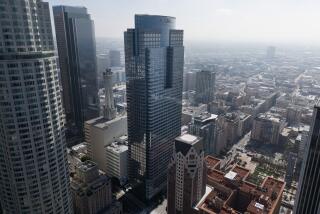Shearson Still Faces Some Tough Decisions
NEW YORK — Shearson Lehman Hutton has managed to maintain its credit ratings with plans for a $900-million capital infusion, but Wall Street’s struggling No. 2 firm needs a lot more to reverse its fortunes after the difficulties of the past year.
The investment giant announced last week that it plans to sell 20 million new shares of common stock, as well as blocks of new preferred stock and debt securities, to raise its capital by 17%, to about $6 billion. In reaction, Moody’s, the credit rating agency, promptly announced that it wouldn’t drop Shearson’s credit rating, as it had threatened.
But while the money is much needed, it won’t instantly clear up Shearson’s operating problems. The firm’s profit margins are lower than those of most of its competitors.
Some analysts predict that Shearson’s net profit margin for 1989 will be about 1% for the second year in a row. By comparison, Salomon Bros.’ margin is expected to be about 6%, Morgan Stanley’s nearly 8% and Merrill Lynch’s about 2%.
Despite the planned capital infusion, Shearson’s credit rating is still lower than those of such key competitors as Merrill Lynch, First Boston, Salomon Bros. and Goldman, Sachs & Co., Moody’s officials say. The lower rating means that the firm must pay more in interest when it wants to raise money.
In its re-evaluation of Shearson, Moody’s cited the company’s exposure in the troubled real estate market. The company’s Balcor subsidiary has commercial real estate loans valued at about $1 billion, said Christopher Mahoney, a Moody’s vice president.
Company officials have emphasized that the real estate portfolio is widely diversified, and thus less risky, and noted that it is only a small slice of Balcor’s total assets of about $75 billion.
Some analysts say Shearson, like so many other firms on Wall Street, still appears to be over-staffed for the amount of business it can expect to generate in the markets’ current sluggish state. Although Shearson has recently announced an 800-employee cutback, “to be in really good shape, they might need another 10% cut,” said Perrin Long, an analyst with Lipper Analytical Securities in Manhattan.
Analysts say Shearson’s strengths include its huge retail brokerage arm. The productivity of its brokers in generating commissions is among the highest in the industry, said Lawrence Eckenfelder, an analyst with Prudential-Bache Securities in San Francisco.
The firm’s money-management arm rates fairly high compared to the competition. Even though the financial results of the company’s investment banking subsidiary were off 32% in the third quarter, “it has a strong franchise,” Eckenfelder said. Among Shearson’s weaker units are its overseas operations, he added.
Shearson’s financial results have been hurt by a variety of unrelated problems in the past year. Its Boston Co. unit was found to have overstated its income by $30 million. Shearson wrote off $100 million of its investment in MCorp., a troubled Texas financial concern.
The company’s efforts to strengthen its position in mergers and acquisitions have not lived up to expectations. And along with the rest of Wall Street, Shearson has suffered because of the general slowdown in the markets.
Overall, for the first nine months of the year, Shearson’s profits were $106 million, down 3% from last year’s $110 million.
Analyst Long asserts that Shearson, like others on Wall Street, may simply need to get out of some barely profitable businesses if it is to thrive during the tough times that may lie ahead. The industry as a whole is making very little money trading government bonds, for example, or in selling exchange-listed stocks to institutional customers, he said.
Although many firms remain in these businesses because of a hope of future earnings, “eventually, they’re going to have to recognize them for what they are,” Long said.
More to Read
Inside the business of entertainment
The Wide Shot brings you news, analysis and insights on everything from streaming wars to production — and what it all means for the future.
You may occasionally receive promotional content from the Los Angeles Times.







